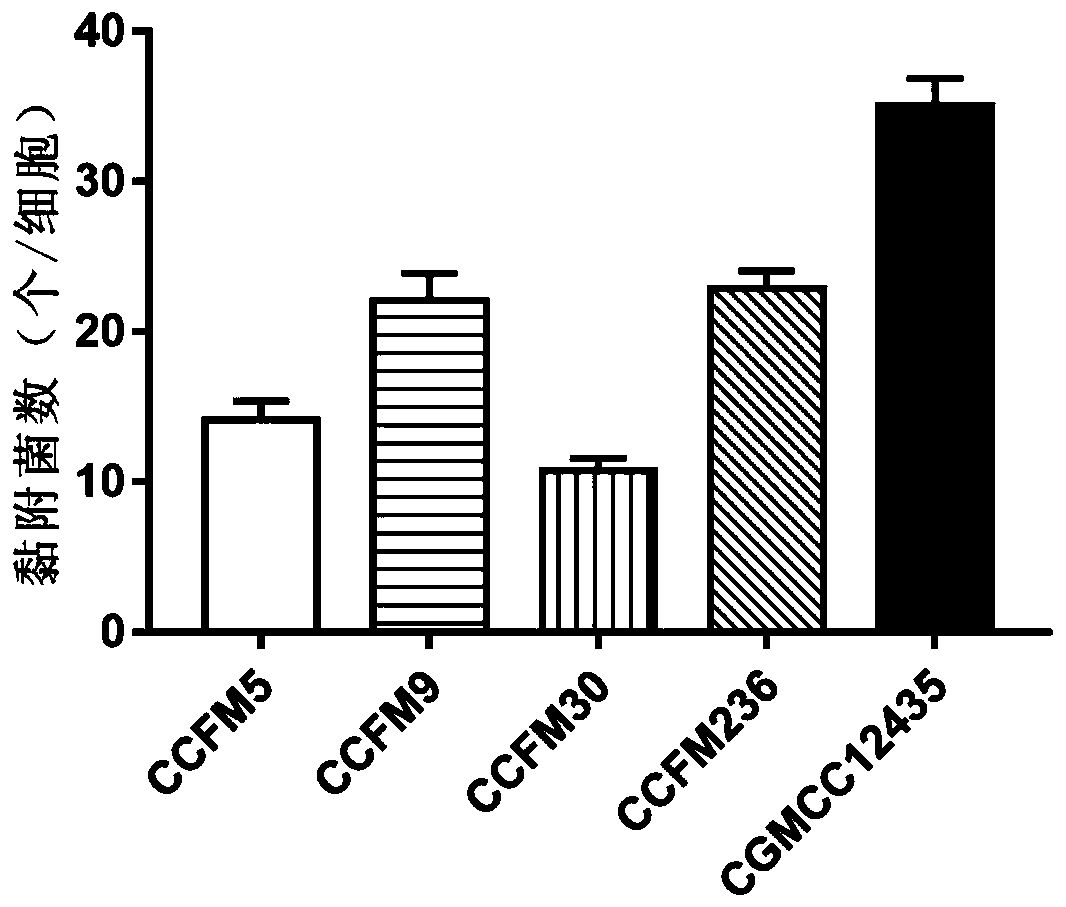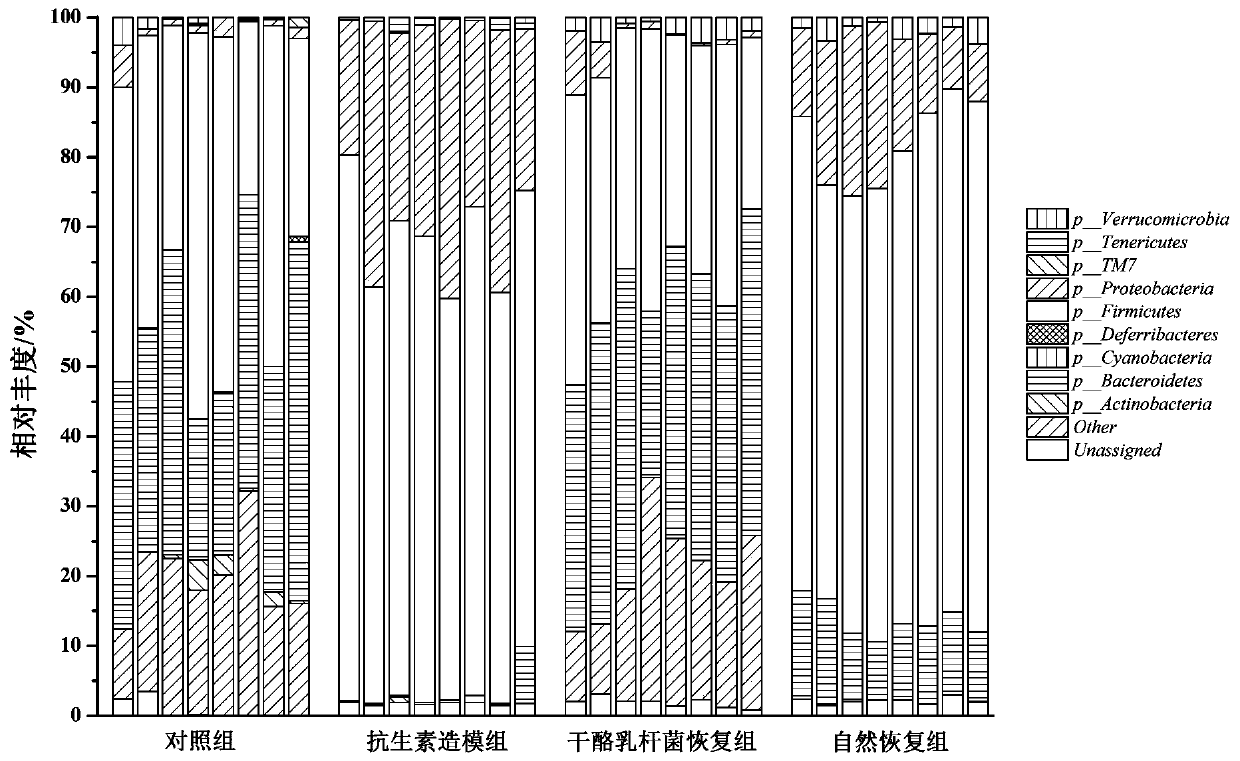A Lactobacillus casei with regulation of antibiotic-induced flora structure disorder
A Lactobacillus casei and microorganism technology, applied in the field of Lactobacillus casei, can solve problems such as blanks, and achieve the effects of long shelf life, alleviation of oxidative stress damage, and high content of active ingredients
- Summary
- Abstract
- Description
- Claims
- Application Information
AI Technical Summary
Problems solved by technology
Method used
Image
Examples
Embodiment 1
[0034] Embodiment 1: The survival rate determination of different Lactobacillus casei in artificial simulated gastrointestinal fluid
[0035] Prepare simulated gastrointestinal juice, simulated gastric juice (6.2g / L NaCl, 2.2g / L KCl, 0.22g / L CaCl 2 ,1.2g / LNaHCO 3 , 0.3% pepsin) was adjusted to pH 2.0 with 6M HCl, and the small intestinal fluid (6.4g / LNaHCO 3, 0.239g / L KCl, 1.28g / L NaCl and 0.1% pancreatin), adjusted to pH 7.4 with 6M HCl. After fully dissolving, the simulated gastric juice and intestinal juice were sterilized by filtration with a 0.22 μm microporous membrane and dispensed into 5 mL in each test tube, and refrigerated at 4°C for later use. Centrifuge the lactic acid bacteria cultured for 18 hours, resuspend and metabolize with 0.9% normal saline for 2 hours, then insert into simulated gastric juice and mix well; draw another 100 μL of gradient dilution plate counting method for counting.
[0036] Set the temperature of the oscillating water bath to 37°C, and...
Embodiment 2
[0042] Embodiment 2: Lactobacillus casei grows in the culture medium that oligosaccharide is the sole carbon source
[0043] Production medium: 4g fructooligosaccharide, 2g tryptone, 1g yeast extract, 2g KH 2 PO 4 , 0.002g MgSO 4 ·7H 2 O, 0.08g NaCl, 8mg CaCl 2 , 0.73mg FeSO 4 ·7H 2 O, 1.2mg hematin, 10mL ATCC vitamin mixture, 10mL ATCC trace mineral, 0.5mL Tween 80, 0.5g L-cysteine hydrochloride, add water to 1000mL, adjust the pH to 7.0, and sterilize at 115°C for 20min. Among them, the fructooligosaccharide is added to the culture medium after being sterilized through a 0.22 μm filter membrane. When separating bacteria, add bromocresol purple solution with a mass concentration of 0.5% as indicator, and the added amount is 15mL / L.
[0044] Use the single carbon source of fructooligosaccharides-bromocresol purple (discoloration 5.7-6.2) solid MRS medium to measure the utilization of probiotics to fructooligosaccharides: growth indicates that oligosaccharides do not i...
Embodiment 3
[0049] Embodiment 3: Comparison of adhesion performance of different Lactobacillus casei to human intestinal cells
[0050] HT-29 cells were cultured in RPMI 1640 (10% fetal bovine serum, 1% antibiotics) medium, and the medium was changed every two days until the cells reached 80-90%. Adjust cell concentration to 1 x 10 5 cells / mL, inoculated in a six-well culture plate, put a 18×18mm sterile coverslip in the culture plate, and place it at 37°C, 95% air / 5% CO 2 Culture in an incubator until a dense monolayer of cells grows. After the cells were washed twice with PBS buffer, 1 mL of antibiotic-free RPMI medium and 1 mL of cultured and resuspended bacteria suspension in PBS were added to each well (the total number of bacteria was 10 8 ), mixed and incubated in an incubator, each strain had three parallels. After culturing for 2 h, the culture plate was taken out, and the cells were washed with PBS buffer until the non-adhered lactic acid bacteria were removed. After adding ...
PUM
 Login to View More
Login to View More Abstract
Description
Claims
Application Information
 Login to View More
Login to View More - R&D
- Intellectual Property
- Life Sciences
- Materials
- Tech Scout
- Unparalleled Data Quality
- Higher Quality Content
- 60% Fewer Hallucinations
Browse by: Latest US Patents, China's latest patents, Technical Efficacy Thesaurus, Application Domain, Technology Topic, Popular Technical Reports.
© 2025 PatSnap. All rights reserved.Legal|Privacy policy|Modern Slavery Act Transparency Statement|Sitemap|About US| Contact US: help@patsnap.com



